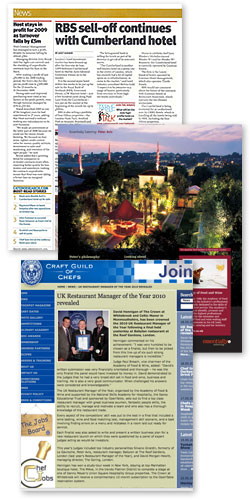- Overcapacity in the market slowing growth
- Menu prices remaining unchanged
- Olympic Games good news for home delivery
Overcapacity in the UK’s eating out market is likely to slow growth in the sector in the longer term by putting downward pressure on like-for-like sales, while competition amongst operators for new sites will continue to intensify.
Issuing its predictions for the foodservice market in 2016, leading foodservice consultancy Horizons says that relentless growth amongst group operators has driven outlet numbers upwards, largely offset by a drop in independently-run businesses.
Over the past decade growth in the number of food-serving outlets has been strongest in the pub sector where operators have moved primarily from wet-led sales to food-led. Horizons figures show the number of pub restaurants in the UK whose food sales exceed their wet sales has grown from 2,600 in 2001 to 6,100 in 2014 – a 135% increase.
The number of chain restaurants has also shown strong growth, from 7,700 outlets in 2001 to some 11,900 in 2014, a 55% rise. Quick service restaurants [primarily takeaways, home delivery and counter-order outlets] have seen a 78% growth, from 7,600 outlets in 2001 to 13,500 in 2014.
“It is difficult to see how this level growth in food outlets can be sustained in the longer term,” said Peter Backman, managing director, Horizons.
“Competition amongst operators means there will be a struggle to improve like-for-like sales across the sector, keeping menu prices fairly flat and margins low.”
Horizons anticipates further blurring of eating out formats as we move into 2016 and operators seek to differentiate themselves. We have already seen the move into new locations such as shopping malls, leisure outlets and transport hubs, but now businesses are broadening their offer. Pret a Manger, for example, has developed a sit-down evening food offer; Starbucks has turned its London Covent Garden site into a high-tech, wine bar offering platters of food in the evening; and Costa, as well as Starbucks, has joined forces with a healthy food brand.
“Consumers are looking for a good quality eating experience wherever they are. This, and the pressure on sites means that operators are being extremely innovative and changing their offer to adapt,” added Backman.
The impact of the National Living Wage, which, although an informal benchmark, will also be significant during 2016 as employers seek to hold on to good staff by paying the recommended hourly minimum wage. Competition for staff will inevitably push wages to this level across the sector.
When it comes to food trends, Horizons predicts that dishes are likely to become ever-hotter and more exotic with influences from South America and Brazil, inspired by the 2016 Olympic Games in Rio. Home delivery will benefit from the Games as consumers opt to stay at home to watch the major events. The home delivery market is already fast-evolving with the likes of Deliveroo and Just Eat expanding their businesses.
“The year ahead is likely to be a challenge for operators with competition at its most intense. Those that maintain their quality, keep their menus fresh, their prices competitive and adapt to changing demand will emerge the winners,” said Backman.
[ends]
_______________
For more details or comment contact Linda Pettit at Tilburstow Media Partners on 01342 832866 / 07973 789853 or email Linda@tilburstowmedia.co.uk. Alternatively contact Horizons on 0844 800 0456 or email info@hrzns.com.
Editor’s Note
Horizons helps its clients make better business decisions by providing accurate and detailed information about the foodservice market, its trend, and opportunities. The company provides consultancy services, workshops and statistical information based on its model of the sector and database of key accounts across Europe.






